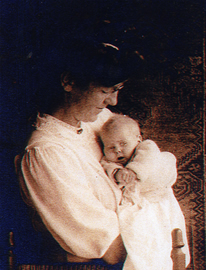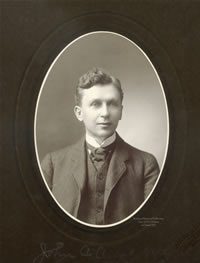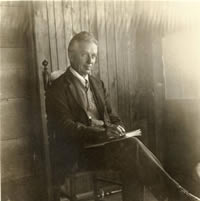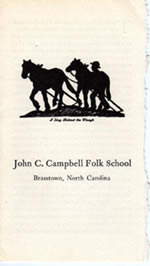The People:
John C. Campbell
John Charles Campbell (1868-1919 1) never saw the school that today bears his name. The John C. Campbell Folk School was founded in 1925 by his widow, Olive Dame Campbell. Earlier in the 20th century, both Campbells traveled the Southern mountains creating a chronicle of mountain life. John collected facts and figures; Olive collected ballads and poetic lyrics. Through personal magnetism and strong organizational skills, each made significant contributions to the movement known as “Mountain Work."
An educator whose teaching was focused in the South, early in his career, John Campbell was principal of Pleasant Hill Academy in Tennessee. At the time, no one could have predicted that Pleasant Hill would later play a significant role in the Craft Revival. In the 1920s and 1930s, Pleasant Hill Academy became known for an educational program in woodcarving that taught hand-eye coordination through hands-on activity. More ironic is the fact that the woodcarving program was supervised by a teacher named Margaret Campbell. While there is no evidence that Margaret Campbell ever met John Campbell—they are certainly no blood relation—much later Margaret Campbell was invited to the John C. Campbell Folk School to teach the school’s first course in woodcarving. 2
John Campbell was a self-confessed “wanderer in the mountain section of the South.” After teaching at several Southern schools, he was appointed president of Piedmont College in Demorest Georgia. Campbell wrote about his fondness for Demorest, but claimed he “broke down from over work in an effort to secure an endowment” for the college. 3 In this same period his wife, Grace H. Buckingham Campbell, died a premature death, leaving him depressed and unstable. Leaving Demorest, Campbell set sail for Europe. On board ship, he met Olive Arnold Dame of West Medford, Massachusetts. Their marriage in 1907 began a lifetime of collaboration.

In the fall of 1908 John Campbell began a study of mountain life with support from the Russell Sage Foundation, a philanthropic social service foundation. Accompanied always by his wife and collaborator, the two traveled into remote sections of the upland South by rail, wagon, horseback, and sometimes on foot, collecting data about rural life. Olive Campbell wrote about one such journey, “[W]e had to walk over Pine Mountain, for the trail was too slippery for horseback. It was a long hard trip for John, climbing up the steep trail in the snow and ice. We took it slowly, with frequent stops to admire the beauty of the woods, and to catch our breath. Even after we reached the top, the down trip was not easy. We slipped and slid over the uncertain footing.” 4
Through his study of mountain life, by 1910 John Campbell reached the conclusion that the “dominant strain in the mountain section of the Southern Appalachians is Scotch-Irish,” 5 a claim that would later contribute to the idea that mountain people were of “pure” Anglo stock. He is also credited with drawing the first map of the region 6 and with popularizing the term “Southern Highlands,” conjoining the term American South with Scottish Highlands. After John died in 1919, Olive Dame gathered his notes together and organized them into the book, Our Southern Highlander and His Homeland published posthumously in 1921 under his name.
During the twenty years of their travels through the region, John and Olive Campbell met many people and became a kind of hub around which a number of conversations evolved. Foremost among these ideas were notions about rural education, uplift, and religion, woven together by the popularity of the Social Gospel. Unlike the isolationist philosophy of many religions today, the Social Gospel challenged religious congregations to actively demonstrate their faith through works of charity and service. Joining the voices of other like-minded progressives, John Campbell was a critic of child labor, cotton mills, and the exploitation and profanity of life in lowland mill towns and mountain coalfields. While not overtly denominational themselves, John and Olive worked among others whose support came directly from church mission boards. At a conference in Atlanta in 1909, they met Bishop Junius Horner, who would establish the Appalachian Industrial School at the site of today’s Penland School of Crafts.
But in those earliest days of John Campbell’s study, crafts were not a part of the discussion. Craftwork would evolve later as a strategic means toward economic self-sufficiency. Still, along the way, John and Olive met many key figures who played a role in the Craft Revival. Among their colleagues were Katherine Pettit, May Stone, Helen Dingman, and William Frost of Kentucky; Martha Berry of Georgia; and Warren Wilson and Frances Goodrich of western North Carolina. Through their association with the Russell Sage Foundation, the Campbells also met a number of national figures including Philander P. Claxton, US Commissioner of Education; social science pioneer Jane Addams; Martha Gielow of the Southern Industrial Education Association, and leaders of the American Red Cross, Peabody Education Fund, and the African-American-based Jeanes and Rosenwald Foundations.
Neither John nor Olive appeared to have been slowed down by the birth—and tragic death in 1912—of their infant daughter Jane, who did not live to see her first birthday. Instead, they appear to have thrown themselves more deeply into their work. Over the next few years, the Campbells were instrumental in bringing mountain workers together at an annual conference. Immediately afterward, they moved into a home in Asheville, North Carolina where they remained for the next seven years.
The formation of the Council of Southern Mountain Workers made a dramatic change in the way mountain work was done. Under the Russell Sage funding umbrella, the Campbells planned conference programs held each April in Knoxville, Tennessee. By 1914, the conference appears to be wholly under the direction of John Campbell, who outlined its purpose “to promote the acquaintance among those engaged in the work of the Southern Highland region and, through an exchange of ideas, to further the best methods of work.” 7 After John’s death in 1919, Olive continued to direct the conference until 1928.
In 1926, at Olive Campbell’s invitation, Allen Eaton delivered a guest lecture on Mountain Handicrafts: What They Mean to our Home Life and to the Life of our Country, a presentation illustrated with lantern slides borrowed from the Metropolitan Museum of Art. This was the beginning of a long and fruitful collaboration that focused on hand craft. The annual conference allowed for the planning and implementation of long-term projects involving numerous partnerships and produced, among other things, a cooperative marketing guild (1930); a Department of Labor study (1933); a nationally touring exhibition (1933); a commercial marketing arm (1935); and a privately funded survey (1937).
Even though John Campbell died many years before the founding of the school that bore his name, his philosophy is said to be the basis for many of its ideas. In a letter to his supervisor, John Glenn of the Russell Sage Foundation, Campbell wrote of his desire to support the “out-of-door life,” rather than the “artificial life of labor indoors.” True to his egalitarian nature and spirit of cooperation, he criticized mountain work done “for the mountaineer,” claiming “all work must be done with the mountaineer.” 8 In a biographical sketch written at the time of his death, John C. Campbell’s “work in the mountain field” was credited with inspiring “closer co-operation, the elimination of many obsolete methods in school work, [and a] better adaptation of school and church programs to meet real needs.” 9
- M. Anna Fariello, 2006
1. According to Olive Dame Campbell, John’s widow, John Campbell’s birth date is September 15, 1868. The University of North Carolina, which owns Campbell’s papers, has his date as September 14, 1867.
2. John C. Campbell Folk School No. 10 (annual bulletin), Oct. 1930, in the John C. Campbell Folk School Archives.
3. John C. Campbell to James C. Rogerson, November 11, 1908, reprinted in Olive Dame Campbell, The Life and Work of John Charles Campbell (Madison, Wisconsin: private printing, 1968) 128.
4. Campbell, The Life, 559.
5. John C. Campbell letter to John Glenn, April 19, 1910, in Campbell, The Life, 220.
6. Erik G. Lovik, Campbell, “John C. and Olive Dame,” Encyclopedia of Appalachia (Knoxville: U of Tennessee Press, 2006) 1528-1529.
7. Conference of Southern Mountain Workers call for participation, 1914, in Campbell, The Life,
8. John C. Campbell to John Glenn, March 9, 1910, in Campbell, The Life, 581; John C. Campbell to Charles Lyman, March 15, 1918 in Campbell, The Life, 215.
9. John F. Smith, John C. Campbell Dies, May 15, 1919, located in the Berea College Archives.






